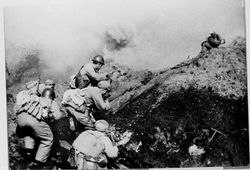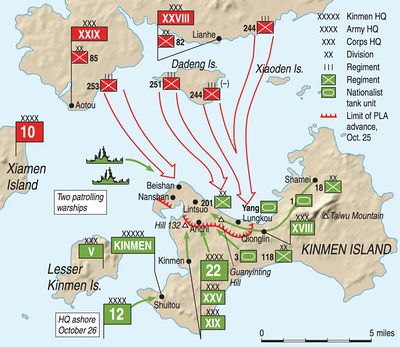معركة جزر ييجيانگشان
| ||||||||||||||||||||||||||||||
معركة جزر ييجيانگشان (الصينية المبسطة: 一江山岛战役; الصينية التقليدية: 一江山島戰役؛ إنگليزية: Battle of Yijiangshan Islands) كانت نزاعاً بين قوات الجيش الثوري الوطني (NRA) لـجمهورية الصين وجيش التحرير الشعبي (PLA) لـجمهورية الصين الشعبية، على واحد من آخر معاقل القوات الوطنية (ROC) بالقرب من بر الصين الرئيسي على جزر ييجيانگشان. نشب النزاع من 18 يناير حتى 20 يناير 1955، أثناء أزمة مضيق تايوان الأولى، وأسفر عن انتصار جيش التحرير الشعبي والتدمير الكامل لحامية جمهورية الصين.
افتتاحية
مع اندلاع الحرب الكورية في 1950، نشر الرئيس الأمريكي هاري ترومان الأسطول السابع الأمريكي للدفاع عن تايوان. فأوقف ذلك الهجمات الصينية للاستيلاء على الجزر القريبة من بر الصين الرئيسي. وما أن تولى دوايت أيزنهاور رئاسة الولايات المتحدة في 1953، حتى سحب الأسطول السابع. مما سمح للجيش الوطني ببناء تحصينات ووضع قوات على الجزر المتقدمة، وكان رد جيش التحرير الشعبي (الصين الشعبية) هو التصعيد من جانبه أيضاً مستخدماً فائض التسليح الغربي للصين أثناء الحرب العالمية الثانية، والطائرات والمدفعية الثقيلة التي حصلت الصين عليها من الاتحاد السوفيتي أثناء الحرب الكورية. فنشبت سلسلة من تبادل القصف المدفعي الثقيل والاشتباكات، سميت لاحقاً أزمة مضيق تايوان الأولى.[1]
الجغرافيا
تتألف جزر ييجيانگشان من جزيرتين، جزيرة ييجانگ (الصينية: 北一江) إلى الشمال وجزيرة ييجيانگ (الصينية: 南一江) إلى الجنوب، وتبلغ مساحتهما معاً نحو 1.2 كيلومتر مربع. Due to its strategic location near the coast of ژىجيانگ, it had become a forward base for the Nationalist defense of Chinese coastal islands centered on Dachen Island, as well as a base for launching guerrilla attacks on بر الصين الرئيسي.
القوات المتقابلة
قوة الدفاع الوطنية تكونت من الوحدات التالية and totaled more than 1000: Yijiangshan Regional Headquarters
- The 2nd Assault Group
- The 4th Assault Group
- The 4th Assault Squadron
- One artillery squadron
In addition, the Nationalist defenders had access to air and naval support.
The Communist attackers totaled more than 5,000, with the landing force totaling one regiment and one battalion from the following units:
- The 178th regiment of the 60th Division of the 20th Army
- The 180th regiment of the 60th Division of the 20th Army
- 137 naval vessels, (including more than 70 landing vessels, and more than 40 escort vessels).
- 184 aircraft from a total of 22 groups, 7 artillery battalions, and 2 anti-aircraft artillery regiments assigned to support the landing force.
In addition, over 30,000 civilians and three dozen civilian ships were mobilized for logistical support.
المعركة
When the fight began on January 18, 1955, the Nationalist air force and navy did not initially participate due to overwhelming Communist firepower. The battle started at 08:00 with People's Liberation Army (PLA) bombers from three groups and ground attack aircraft from 2 groups bombing and strafing the islands. At the same time, bombers from another group and ground attack aircraft from the second group began bombing and strafing the Dachen Islands as a diversion. At 09:00, 50 long range artillery pieces shelled the Yijiangshan Islands.
Around noon, 70+ naval vessels carrying the landing force sailed from Gaodao (الصينية: 高岛), Queerao (الصينية: 雀儿岙), Toumenshan Island (الصينية: 头门山岛) in three formations in two waves, with more than 40 escort vessels. 2 hours later, the 10 specially converted naval vessels with rocket launchers bombarded Yijiangshan island in conjunction with bombers from 3 groups and 1 squadron, ground attack aircraft from 2 groups, before landing on 20 landing spots. However, the defenders took advantage of their fortifications and severely disrupted the attackers’ formation after their successful landing. As a result, most of the Communist casualties suffered during the battle were at this initial stage.
The Communists immediately called for fire support after they met with fierce enemy fire, and PLA aircraft responded by attacking enemy positions at extremely low altitude. With the first line of defence was quickly overpowered by flamethrowers, bombs, and artillery, the PLA gained ground rapidly. Most of the PLA casualties (as many as 200 dead and 400 wounded) resulted from attacks on two machine gun nests. Air strikes and massive artillery bombardments eventually knocked out these two positions. As the demoralized defenders retreated into their underground tunnels, the attackers changed their tactics by fighting in small groups, and using recoilless rifles and flamethrowers to gradually torch the NRA soldiers to death, including the underground tunnel complex of the Nationalist 4th Assault Group—the largest on the island.
By 17:30, the battle on the islands subsided with the PLA having taken 95 hills over 132 meters, and the decimation of the NRA defenders was almost complete with 567 killed (mostly burned by the flamethrowers) and 519 captured alive according to the often exaggerated PRC source; or 712 soldiers and 12 nurses died in the line of duty according to the Taiwan source. The Communist forces were then ordered to assume a defensive posture for the next day, to prepare for a possible Nationalist counterattack that never materialized. Wang Shen-Ming (الصينية: 王生民), the NRA commander was on the phone mentioned he was 502 yards (45.72 meters) from the approaching Communists. He committed suicide with a hand grenade, ended all the communication and resistance at his 121 hill cave headquarter. Also on the January 19, the Communist force begun their shelling on Dachen Archipelago about 13.2 kilometers (8.12 miles) away, but these actions were still originally intended to prevent possible counterattacks. Finally, on January 20, 1955, the islands were formally declared to be firmly in PLA control.
الأعقاب
The strategic scale of the battle was minute, and the most important gain of the PLA was demoralizing the NRA willpower to continue holding on to some of the islets difficult to defend. The Nationalists became aware that the logistics to send support from Taiwan Island was difficult with its antiquated air force and a lack of strong Navy. The Nationalists lost a destroyer, named Taiping. The Korean War by then was over. The PLA had ample military resources including MiG jets, and warships to focus on wiping out anti-Communist resistance. This was the prelude to the eventual abandonment of Dachen island with the الولايات المتحدة urging Taiwan not to spread too thin. According to Taiwan sources, the troops garrison consists of mostly former fishermen/pirates and civil war refugees. Some of the casualties were female interns from a Political Warfare College. There are a number of shrines, roads, and even a restaurant today to commemorate the Nationalist resistance on Taiwan.
Over 500 bombs and 50,000 shells were fired over the two rocky islets. PLA launched an amphibious assault with 182 aircraft, bombers, long distance artilleries. Over 5,000 troops were landed with the mobilization of 30,000 civilians. The battle was considered an example of PRC's modern warfare in its showcase of modern military strategy and equipment.
انظر أيضاً
- List of Battles of Chinese Civil War
- الجيش الثوري الوطني
- History of the People's Liberation Army
- الحرب الأهلية الصينية
- Chekiang Province, Republic of China
الهامش
- ^ Sebastien Roblin (2017-02-19). "When America Threatened to Nuke China: The Battle of Yijiangshan Island". The National Interest. Retrieved 2017-05-30.
المراجع
- Zhu, Zongzhen and Wang, Chaoguang, Liberation War History, 1st Edition, Social Scientific Literary Publishing House in Beijing, 2000, ISBN 7-80149-207-2 (set)
- Zhang, Ping, History of the Liberation War, 1st Edition, Chinese Youth Publishing House in Beijing, 1987, ISBN 7-5006-0081-X (pbk.)
- Jie, Lifu, Records of the Libration War: The Decisive Battle of Two Kinds of Fates, 1st Edition, Hebei People's Publishing House in Shijiazhuang, 1990, ISBN 7-202-00733-9 (set)
- Literary and Historical Research Committee of the Anhui Committee of the Chinese People's Political Consultative Conference, Liberation War, 1st Edition, Anhui People's Publishing House in Hefei, 1987, ISBN 7-212-00007-8
- Li, Zuomin, Heroic Division and Iron Horse: Records of the Liberation War, 1st Edition, Chinese Communist Party History Publishing House in Beijing, 2004, ISBN 7-80199-029-3
- Wang, Xingsheng, and Zhang, Jingshan, Chinese Liberation War, 1st Edition, People's Liberation Army Literature and Art Publishing House in Beijing, 2001, ISBN 7-5033-1351-X (set)
- Huang, Youlan, History of the Chinese People's Liberation War, 1st Edition, Archives Publishing House in Beijing, 1992, ISBN 7-80019-338-1
- Liu Wusheng, From Yan'an to Beijing: A Collection of Military Records and Research Publications of Important Campaigns in the Liberation War, 1st Edition, Central Literary Publishing House in Beijing, 1993, ISBN 7-5073-0074-9
- Tang, Yilu and Bi, Jianzhong, History of Chinese People's Liberation Army in Chinese Liberation War, 1st Edition, Military Scientific Publishing House in Beijing, 1993 – 1997, ISBN 7-80021-719-1 (Volum 1), 7800219615 (Volum 2), 7800219631 (Volum 3), 7801370937 (Volum 4), and 7801370953 (Volum 5)
وصلات خارجية
- Pages using gadget WikiMiniAtlas
- Articles containing simplified Chinese-language text
- Articles containing traditional Chinese-language text
- Articles containing إنگليزية-language text
- Pages using Lang-xx templates
- Articles containing Chinese-language text
- Coordinates on Wikidata
- معارك الحرب الأهلية الصينية
- نزاعات 1955
- 1955 في الصين
- أحداث يناير 1955

